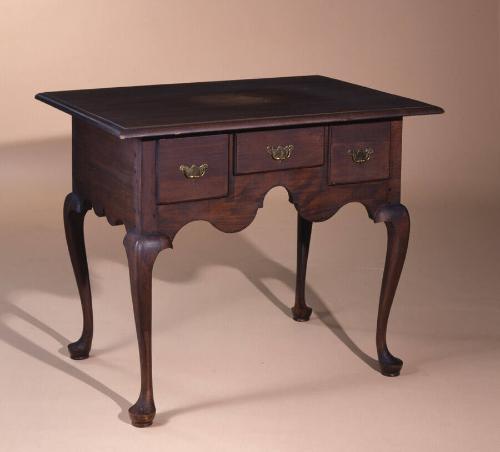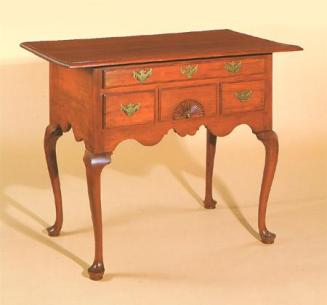Dressing Table
Original OwnerOriginally owned by
Lydia Belden
(American, 1725 - 1805)
Original OwnerOriginally owned by
Captain Charles Churchill
(American, 1723 - 1802)
Furniture MakerPossibly made by
Return Belden
(American, 1721 - 1764)
Date1740-1760
MediumSycamore and maple primary wood, eastern white pine and yellow pine secondary wood, brass hardware
DimensionsPrimary Dimensions (overall height x width x depth): 27 3/8 x 33 1/2 x 23 1/2in. (69.5 x 85.1 x 59.7cm)
ClassificationsFurniture
Credit LineBequest of George Dudley Seymour
Object number1945.1.1127
DescriptionSycamore and maple dressing table in the Queen Anne, or late baroque, style with local characteristics associated with the William Manley group of case furniture. The replaced top has ovolo, or thumbnail, molding on all four sides. The drawer arrangement consists of one shallow drawer flanked by two deep drawers. The front skirt has a high center arch flanked by deep cyma curves, or S-curves. Each side skirt has a cyma curve and reverse cyma curve. The maple cabriole legs each end in a pad foot supported by a truncated cone. Hardware includes a blind brass lock escutcheon on the center drawer. The two side drawers have a single brass escutcheon with a bail pull.
Condition: The top and the knee returns are replacements. The top is attached with screws to the front rail and to strips of wood glued to the sides and back. The finish on top is matte, with the exception of a glossy area in the center. The front left corner of the top is missing two small chips of wood. The two left leg posts have dormant insect holes; additional small insect holes are located throughout the lower case. The hardware is replaced.
Design and Construction Details: The case is made with mortise-and-tenon construction. The backboard is tenoned into the leg posts. There is a rail above the top drawer. The vertical partitions between the drawers are attached at each end with an exposed dovetail. Each knee return has a simple, rounded profile and is applied to the front of the apron. The drawers are supported by pairs of runners that are tenoned into the backboard. The drawer fronts are lip-molded; the drawer sides have double astragal molding on top. The drawer bottoms fit into grooves in the front and sides of each drawer; the underside of each drawer bottom shows frame-saw marks. Dovetail pins are an average size and angle.
Please see attached essay by Dr. Thomas P. Kugelman for more information about this piece.
NotesHistorical Note: Lydia Belden (1725-1805) was the younger sister of the maker, Return Belden (1721-1764).Condition: The top and the knee returns are replacements. The top is attached with screws to the front rail and to strips of wood glued to the sides and back. The finish on top is matte, with the exception of a glossy area in the center. The front left corner of the top is missing two small chips of wood. The two left leg posts have dormant insect holes; additional small insect holes are located throughout the lower case. The hardware is replaced.
Design and Construction Details: The case is made with mortise-and-tenon construction. The backboard is tenoned into the leg posts. There is a rail above the top drawer. The vertical partitions between the drawers are attached at each end with an exposed dovetail. Each knee return has a simple, rounded profile and is applied to the front of the apron. The drawers are supported by pairs of runners that are tenoned into the backboard. The drawer fronts are lip-molded; the drawer sides have double astragal molding on top. The drawer bottoms fit into grooves in the front and sides of each drawer; the underside of each drawer bottom shows frame-saw marks. Dovetail pins are an average size and angle.
Please see attached essay by Dr. Thomas P. Kugelman for more information about this piece.
Status
Not on view











